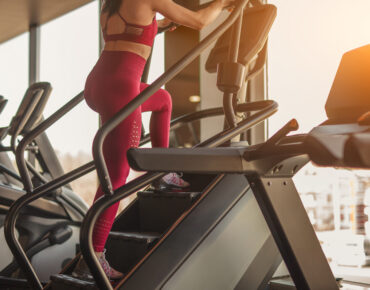You’re probably climbing steps just about every day. But getting step-ups right calls for a bit more attention to form.
The step-up exercise is great for runners who want to improve lower body strength. It can also be integrated into aerobic training and general bodyweight workouts. You don’t need any fancy equipment to do step-ups. Plus, they don’t put too much stress on your body.
So, what are step-ups exactly, and how do you do them right? Discover the benefits of step-ups, how to do them right, and how frequently.
In This Article:
How to Do Step-Ups With Proper Form
Doing a step-up looks very easy. And it’s precisely because of that that you may not pay enough attention to proper form. To reap all the benefits of the exercise, focus on quality over quantity. And before you do it, set yourself up for it properly.
What can I use for step-ups at home?
For the simple version of the exercise, you can use a bench, a step stool, a chair, the bottom step of a staircase, or even some stacked crates.
An adjustable bench is often the most convenient, especially if you want to explore different variations of the exercise. Whatever you use, make sure it’s solid and stable enough to bear your weight.
Set it up at a height lower than the maximum you can handle. As you become familiar with the exercise, you can increase the height. For some variations of the exercise, you’ll also need weights. But we’ll talk about that later in this guide.
How to do step-ups
1. Stand tall before the bench or platform you use.
2. Place your arms on your shoulders or straighten them in front of you at shoulder level.
3. Step onto the bench with one foot while keeping the other flat against the bench.
4. Engage your abs, lean forward a little, and drive through the heel of your foot to pull yourself into a standing position on the bench. During this movement, contract your glutes and quads.
5. Keeping your upper foot on the bench, lower your other leg to the ground with a controlled movement. Keep your abs braced and your hips and shoulders level.
6. Repeat the movement with the other leg. Or, if you prefer, you can do all the reps with one leg before switching to the other.
How many step-ups should I do?
Start with 10 reps per leg. You can do 3 sets initially and then increase these progressively to 5 sets. In between sets, give yourself a 2-minute break. As with all aerobic exercises, it’s best to increase reps gradually to prevent injury.
How frequently should I do step-ups?
While you probably climb steps almost every day, you don’t have to overdo step exercises. Do them 1–3 times a week or according to your training plan. A personalized training plan adapted to your fitness goals will help you make the most of your step-up workout.
Benefits of Step-Up Exercises and Muscles Worked
So, what muscles do step-ups work exactly? Step-ups work all the main upper leg muscles, including the quadriceps, hamstrings, and glutes. They can strengthen all these muscles and help you burn fat. What’s more, they also support conditioning.
Glute strength
Doing squats to work your glutes? A 2020 study found that step-ups are better at working the gluteus maximus and medius than regular squats.
More than keeping you upright, strong glutes play a key role during running. Working your glutes can give you an extra oomph during the propulsion phase of running.
Hamstrings
The hamstrings are the three muscles at the back of your thigh. They play a key role in most leg movements, including walking, running, and climbing stairs.
Step-ups work your hamstrings alongside your glutes. But the height of the steps matters. To maximize the effects of step-ups on your hamstrings, perform the exercise on high steps.
Building muscle and body strength
Running mostly on even terrain? Your quads won’t get much of a workout. This may result in underdeveloped quads. Research has associated weak quads with knee pain in women.
Step exercises can help you build lower body muscle and strength. They are an effective exercise for building stronger quads that can better handle the weight of your body when running. Step-ups can also strengthen your knee and hip joints.
Unlike plyometric jumping and other lower body exercises, step-ups have a lower impact on your bones and joints. This makes them a safe exercise for long-distance runners.
Fat loss
Step-ups count as aerobic exercise. You can integrate them with other moderate to high-intensity exercises as part of a weight loss workout. Combined with an appropriate diet, step-ups can help you shed extra pounds.
Conditioning
Trying to stay in good shape and prevent injury? The step-up exercise also works as part of a lower body conditioning workout. More than working your upper leg muscles, you can use it to get your heart pumping. And keep your muscles geared for running and other physical activities.
What’s more, step-ups provide effective proprioceptive training that improves balance and makes you more stable.
Step-Up Variations
Once you accustom your body to the standard step-up, you can try out variations of the exercise. These include normal body weight variations, weighted step-ups, and lateral step-ups. Let’s take a closer look at each one of these.
Normal body weight step-up variations
Up the challenge of the classic step-up with these popular variations.
Step-up with lunge
1. Step up on the bench with your right leg and lift the opposite knee to your chest.
2. Step back with your left leg as you bring your right leg into a backward lunge.
3. Do 10 reps on each side.
High box step-ups
1. Increase the height of the bench or add an extra box to make normal body weight step-ups more difficult. The box can be as high as your thighs as you stand before it.
2. Step up on the high platform with your arms held forward.
3. Then repeat with the other leg.
4. Do 10 reps on each side.
Explosive step-ups
1. Place a box or bench before you that is below knee height.
2. Put your right foot on it.
3. Step up as fast as you can, jumping off the box high with your right leg.
4. Land on your right leg even as you step back with your other leg.
5. Repeat 10 times with the same leg.
6. Switch to the other leg.
Weighted (with a barbell, dumbbell, or kettlebell) step-ups
You can increase the difficulty of the step-up exercise by holding a barbell, dumbbell, or kettlebell as you do it. Weighted step-ups can make the exercise significantly harder, challenging your posture and balance. Start with low, manageable weights before adding on to them.
Tip: Lifting more weight and going slower helps you gain more strength from the exercise.
Barbell step-up
1. Place the barbell on your upper back, holding it with a shoulder grip.
2. Step up on the box with one foot.
3. Do 10 reps before switching to the other foot.
Tips: Use a low box to stay balanced more easily.
Dumbbell step-up
1. Stand before the bench holding a dumbbell in each hand.
2. Engage your core.
3. Raise your right knee and step on the bench.
4. Putting your effort into your right leg, bring your body into a standing position.
5. Lower your body to the starting position.
6. Do 10 reps and switch legs.
Kettlebell step-up
1. Stand before the bench holding a kettlebell in front of your chest by the handle sides.
2. Put your right foot on the bench and step up with your other foot.
3. Step back with the left foot.
4. Do 10 reps and then switch legs.
Lateral step-ups
Lateral step-ups alternate the starting position of the exercise. You may find them somewhat similar to squats.
1. Stand to one side of the bench with your hands on your hips.
2. Put your right foot on the bench, leaving enough room for your other foot.
3. Step up with your left foot and to the side.
4. Once both your feet are on the box, step back with the left leg.
5. Repeat the movement 10 times before switching legs.
Common Mistakes
Step-ups are simple, but you can still get them wrong. Here are some of the most common mistakes you want to avoid. They can reduce the efficiency of the exercise and cause injury.
- Not pushing up with your leading leg. Avoid pushing up with your lower leg. It may be easier, but it reduces the load on the active leg and makes the exercise less effective.
- Pushing the knee far forward so that it passes the toes. This common step-up mistake places more load on the knee joint and may cause knee pain.
- Letting your knee collapse in or out. Keep the knee of your active leg in alignment.
- Starting with a bench or box that is too high. The higher the box, the more difficult the exercise.
- Not holding your torso straight. Even if you have to lean forward slightly, avoid rounding your back.
Tips to Do Step-Ups With Perfect Form
Avoiding common mistakes is the first step to getting the exercise right. Then, to perfect your form, pay attention to a few more things.
- Place most of the weight of your support leg on the midfoot to the heel.
- Aim to create 90-degree angles at your hips, knees, and ankles.
- Make sure that the knee of your active leg trails over your second and third toes.
- For most exercises, optimize the height of the support so that you can maintain a level pelvis and a tall posture.
- Maintain a neutral head and neck position.
- Squeeze your glutes as you begin the upward movement on the box.
In the end, do the step-up exercise slowly, and don’t worry if you don’t get it perfect from the start. Keep practicing, focusing on form, and you’ll make the most of it.
Frequently Asked Questions
What are step-up exercises good for?
Step-ups offer a range of benefits:
- Strength & Power: Builds strength in quads, glutes, hamstrings, calves, and core, improving explosiveness and athletic performance.
- Balance & Stability: Challenges single-leg stability and coordination, enhancing overall movement quality.
- Functional Benefits: Mimics activities like climbing stairs and hiking, translating strength to daily life.
- Variety & Accessibility: Offers diverse variations, suitable for different fitness levels and equipment availability.
How do you do step-ups properly?
- Stand facing a sturdy step or box with good posture.
- Step onto the box with one leg, pushing through your heel for full knee extension.
- Bring your other leg up to meet the standing leg on the box.
- Step back down with the working leg, then repeat with the other leg.
- Maintain a tall spine, engaged core, and neutral knee alignment throughout.
Are step-ups better than squats?
Both offer benefits, but they target muscles differently:
- Squats: Primarily develop quadriceps and core strength, working larger muscle groups simultaneously.
- Step-ups: Emphasize single-leg strength and stability, beneficial for balance and preventing muscle imbalances.
Choosing “better” depends on your goals and needs. Consider incorporating both exercises for a well-rounded workout.
Does step-up reduce belly fat?
No single exercise directly targets belly fat. However, step-ups contribute to overall calorie expenditure, which can aid in weight management when combined with a healthy diet.
Are step-ups OK for bad knees?
Unfortunately, there’s no simple yes or no answer to whether step-ups are okay for bad knees. Several factors influence the answer, which is why consulting a healthcare professional like a doctor or physical therapist is crucial before adding step-ups to your routine.
Here’s a breakdown of why it’s not a straightforward answer:
Potential Benefits for Knees:
- Strengthening muscles: Step-ups can strengthen various leg muscles, including quads, hamstrings, and glutes, which support and stabilize the knee joint. Stronger muscles can lead to better knee health and pain reduction for some individuals.
- Improving balance and stability: Single-leg exercises like step-ups can enhance balance and proprioception (your body’s awareness of its position in space), contributing to better knee control and potentially reducing injury risk.
Potential Risks for Knees:
- Increased stress on the joint: Depending on the severity of your knee issue, the single-leg movement and weight-bearing nature of step-ups might aggravate discomfort or pain.
- Improper form can worsen problems: Incorrect technique can place excessive stress on specific knee structures, potentially leading to further injuries
References
- Worrell, T.W., Borchert, B., Erner, K., Fritz, J. and Leerar, P., 1993. Effect of a lateral step-up exercise protocol on quadriceps and lower extremity performance. Journal of Orthopaedic & Sports Physical Therapy, 18(6), pp.646-653.
- Brask, B., Lueke, R.H. and Soderberg, G.L., 1984. Electromyographic analysis of selected muscles during the lateral step-up exercise. Physical therapy, 64(3), pp.324-329.
- Flanagan, S.P., Kessans, K.M. and Salem, G.J., 2006. Quantifying bilateral joint contributions during three variations of the step exercise. Journal of Sport Rehabilitation, 15(3), pp.254-265.
- Bohannon, R.W. and Crouch, R.H., 2019. Two-minute step test of exercise capacity: systematic review of procedures, performance, and clinimetric properties. Journal of Geriatric Physical Therapy, 42(2), pp.105-112.
- Simenz, C.J., Garceau, L.R., Lutsch, B.N., Suchomel, T.J. and Ebben, W.P., 2012. Electromyographical analysis of lower extremity muscle activation during variations of the loaded step-up exercise. The Journal of Strength & Conditioning Research, 26(12), pp.3398-3405.














